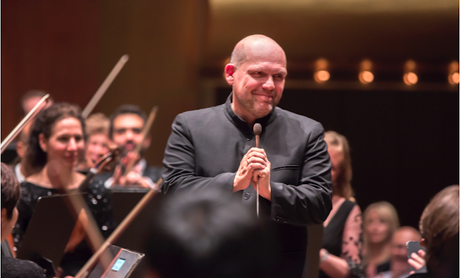by Paul J. Pelkonen

Conductor Jaap van Zweden shows off the latest in controversial baton grips.
Photo by Chris Lee © 2017 for the New York Philharmonic.
Bruckner's Eighth is long and exhausting, so it was a surprise that Mr. van Zweden chose to program it with a sort of appetizer: a one movement work by contemporary composer Conrad Tao titled Everything Must Go. This was conceived by Mr. Tao as a specific companion piece to the big Bruckner, a sort of satellite probe orbiting through a larger symphonic cosmos. It made use of fragmentary sounds heard from every corner of the orchestra, most with their origins in Bruckner's orchestral idiom. There were fragmentary fanfares, isolated woodwind solos, frequent pauses and shards of shimmering string arpeggios. It was an effective lead-in to the big symphony, which followed with no pauses for interruption or applause.
Before delving into the symphony, it must be noted that Mr. van Zweden introduced a radical reconfiguration of the familiar Philharmonic players. Cellos are now in the front, opposite the first violins. The horns are now toward stage right, by the timpani. For this performance, tuba player Alan Baer was moved from his usual stage left corner and placed next to the arsenal of Wagner tubas that supplant the brass in this work. (The Wagner tuba, conceived by the composer whose name it bears, is a small tuba played by a French horn player with a deep and throaty sound.) It is not clear whether these seating changes are permanent.
Among the great teachers that Mr. van Zweden has had in his career is the Dutch conductor Bernard Haitink, whom he served as concertmaster with the Royal Concertgebouw Orchestra. Mr. Haitink's fingerprints were evident in this Bruckner Eighth, which was played in its 1955 edition by Leopold Nowak. From this, Mr. van Zweden created a performance which brought a sense of narrative drive to this abstract music. In the first movement, the recurring solo theme in the woodwind created a sense of crisis and lonely isolation against the big chords of cosmic brass that cascaded in response. Through a succession of rising crescendos, each taller and more elaborate than the last, the work moved with a sense of purpose where often the only reward is sheer volume.
The Eighth does not have one of Bruckner's more violent scherzos. Mr. van Zweden opted for clarity and restraint in the first statement of the dance theme in the second movement, but kept the sense of relentless (if lumbering) forward momentum. Conductor and orchestra moved in perfect synchronicity, from the little pizzicato notes in the violins (another Bruckner trademark) to the surging, breaking waves of rhythm. The strings and winds formed some beautiful textures in the (very slow) trio section, stopping time for zealous contemplation of some wondrous infinite. The scherzo figure returned with a renewed sense of purpose and fury as if the protagonist of the work (Bruckner himself?) had reached a sort of emotional turning point.
Mr. van Zweden and the orchestra mined further depths of profundity in the slow movement, the longest and most leisurely of Bruckner's adagios. When the first climax was reached, it was capped by a simple and lovely horn solo by acting principal Richard Deane. Bruckner called this theme "the voice of God", supported by a hushed chorale of Wagner tubas. By contrast, the inevitable repetition of the theme (Bruckner was a great one for inevitable repetition) sounded vulgar. The gentle Adagio culminated in a surprisingly ferocious climax as the orchestra cut loose at full blast.
So how to end this dark night of the soul? Bruckner opted for a propulsive finale with a theme that starts with the strings fading in from silence, building to a forte against a surging wave from that enormous Wagner tuba-augmented brass section. This crests in a pounding figure for the timpani, almost a crie de couer expressed in percussion. Themes from the previous three movements come back to do battle with this new music. Under their new chief, the Philharmonic players gave this music the sense of triumph over crisis, telling the story of faith renewed and heavenly glory glimpsed, if only in the final, resonant brass chords.

